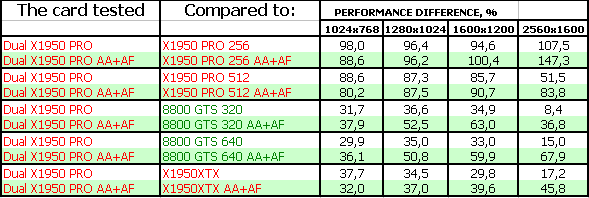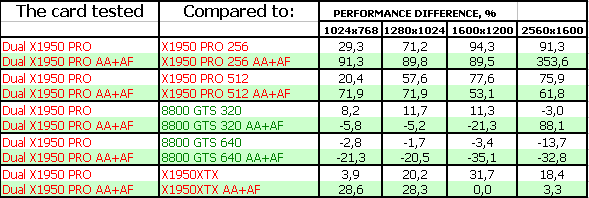 |
||
|
||
| ||
TABLE OF CONTENTSDo you know that when everybody was speaking about Matrox after the launch of Parhelia, that it was too late, that it should have entered the market with a much better solution, and that the card should have been launched a year earlier to have higher chances for success, the reply was: "But then we have an opportunity to connect three monitors in a single field"... OK, some users, may be even 1%, may need that (to be more exact, they might have needed it when huge monitors were very expensive). Even now... R600 and cheaper modifications are on the horizon, but some manufacturers are shouting to the leaving R5xx train: "Wait! We can also install two chips on a single card!" It seemed a utopian idea. Why would we need that? OK, seven years ago (My god! Seven years have passed since Voodoo5 already!!) 3dfx made a dual-chip modification, because all would have been lost otherwise, and there would have been no choice there... And in this case, Sapphire Technology is wasting time, efforts, and money on design of a dual-chip video card based on two RADEON X1950 PRO, while a new series of products from AMD/ATI is to be launched. They may tell me that it's an image product. An accelerator to show off at expos to demonstrate the press what the R&D department can do. But even in this case, why launch it in the very end of RADEON X1950 PRO days, when the entire X1950 series is to be pushed out, written down, and doomed for extinction? That may be a start for future: if the same PCB can accommodate new chips from the new DX10 family, Sapphire will easily launch a dual-processor video card based on the new GPUs. So, we are not sure why the company needs it. One thing is clear: the product is ready for retail, and can be launched for production. Moreover, its specifications run that this video card DOES NOT REQUIRE a motherboard with CrossFire support! That's interesting. But let's not put the cart before the horse. Let's examine the card.
Video Cards
What have we got here? It's a huge monster, like ASUS Dual GeForce 6800GT. It will hardly fit into a usual PC case (have a look at its dimensions!) The R&D department did not get around to think about optimizations and more compact layout of all elements - memory chips do not need much cooling at standard frequencies, so they could have been installed on the rear side of the PCB (some of them). And here, as in case with ASUS Dual 6800GT, two X1950 PRO PCBs were just merged diagonally to free some room for a power supply unit. That's why the card got not only longer, but higher as well. This card did not fit into the PC case of our testbed, so we had to remove all components to run our tests.
The card has TV-Out with a unique jack. You will need special bundled adapters to output video to a TV-set via S-Video or RCA. You can read about the TV-Out in more detail here. Moreover, as we have already mentioned above, the card is equipped with VIVO, so you can convert analog video to digital form. Analog monitors with d-Sub (VGA) interface are connected with special DVI-to-d-Sub adapters. Maximum resolutions and frequencies:
What concerns MPEG2 playback features (DVD-Video), we analyzed this issue in 2002. Little has changed since that time. CPU load during video playback on all modern video cards does not exceed 25%. What concerns HDTV and other trendy video features, we are going to sort them out as soon as possible. Note that the card requires additional power supply (via TWO CONNECTORS!), so there are two black 6-pin connectors at the edge of the PCB. In case your PSU does not have cables with such connectors, the bundle includes two splitters to connect to any Molex. Now what concerns the cooling system.
We've mentioned above some PCI-E switch. There is a chip on the card that splits (in simple words) the common x16 bus into two x8 buses, so that each card inside this accelerator gets PCI-E x8.

Bundle
Packages
Installation and DriversTestbed configuration:
VSync is disabled. PLEASE NOTE! Have a look at the configuration of the testbed, which motherboard is based on NForce 680i. Strange as it may seem, this accelerator actually worked on a motherboard from NVIDIA. Perhaps it's a special driver, developed by ATI for this card by Sapphire's orders. Or the ATI driver cannot see the chipset behind the PCI-E switch... But the fact remains. Of course, CrossFire on nForce is buggy (this technology is not finetuned on such motherboards), but it can still give you the idea. And don't forget that according to some sources this card does not work with some nForce-motherboards at all. If you don't want to have any problems, install this card into a motherboard based on the i975 or ATI/AMD chipset.
Test results: performance comparisonWe used the following test applications:
Video cards' performance
If you understand 3D graphics, you may draw your own conclusions from the diagrams below. If you are interested in our comments on test results, you may read them after each test. What concerns beginners and those who just started to look for a video card, we shall include some detailed explanations. Firstly, you should look through our reference materials on modern video cards and their GPUs. Note operating frequencies, support for modern technologies (shaders), as well as a pipeline architecture.
ATI RADEON X1300-1600-1800-1900 ReferenceNVIDIA GeForce 7300-7600-7800-7900-8800 ReferenceSecondly, if you have just faced the problem of choosing a video card and are at a loss, our 3D-Video section offers articles about 3D basics (you will still have to understand them - when you run a game and open its options, you'll see such notions as textures, lighting, etc) as well as reviews of new products. There are just two companies that manufacture graphics processors: ATI (it has been recently bought by AMD and now bears the same name - AMD) and NVIDIA. So most information is divided into these two sections. We also publish monthly 3Digests that sum up all comparisons of video cards for various price segments. Thirdly, have a look at the tests of this video card from Sapphire. FarCry, Research (No HDR)
 As we can see, the new card from Sapphire leads in all tests. It has easily outperformed even the 8800 GTS card. If the price does not exceed $300, the card will be evidently successful... (but do not forget about some problems with nForce).
FarCry, Research (HDR)
 It's almost a similar situation.
F.E.A.R. Performance gain versus a single X1950 PRO card is also impressive, as well as the victory on the whole. Drawbacks in 2560×1600 can be ignored, because performance in this resolution is too low to play.
Splinter Cell Chaos Theory (No HDR) Pure victory again.
Splinter Cell Chaos Theory (HDR) The same thing.
Call Of Juarez This new game with a huge load on shaders made the victory of the new card pale a little. But don't forget about low FPS in general. That is when Dual X1950 PRO is outperformed, performance is too low to play.
Company Of Heroes The new accelerator again demonstrates brilliant results.
Serious Sam II (No HDR) We cannot add anything.
Serious Sam II (HDR) The victory is not full here probably due to problems with drivers.
Prey The same thing. Besides, OpenGL is ATI's heel of Achilles.
3DMark05: MARKS
3DMark06: SHADER 2.0 MARKS

3DMark06: SHADER 3.0 MARKS

The situation in synthetic tests is natural: the more shader units, the higher performance. So the total of 72 pipelines have put up a great performance.
Conclusions
Sapphire RADEON X1950 PRO DUAL 2×512MB PCI-E is hard to evaluate. On one hand, it's good of Sapphire to design some interesting non-standard products (in the epoch of reference designs). The attempt to use CrossFire with nForce platforms is praiseworthy (they are very popular now). A big fly in the ointment - this solution is quite buggy, and there are some problems with this accelerator working on these platforms. On the other hand, we don't understand who will buy these cards (and a headache how to insert this "airfield" into their computers) on the threshold of R600/RV6xx solutions. CrossFire can evidently work in a single card, but its implementation leaves much to be desired (PCB layout must have been redesigned to make the card more compact). Nevertheless, we should compliment Sapphire for its innovation and spirit to design something on its own instead of manufacturing only reference cards. The choice is up to our readers, as always. We can only inform you about this or that product. But we do not give direct instructions which products to choose. And here is one more thing that will be repeated in each review. Having decided to choose a 3D accelerator on your own (a video card in your computer), you should understand that you change one of the key components of your system unit, which may require additional configuration for better performance or you may have to enable some functions to achieve higher quality. This is not an end product, it's just a component. So you should understand that you'll have to learn 3D graphics basics in order to get maximum performance from a new video card. And some graphics as well. If you don't want to deal with it, you shouldn't upgrade your computer on your own: you'd better buy ready PCs with preconfigured software (you'll also have technical support by your system integrator), or game boxes, where no configuration is required, everything necessary is already configured in a game. You can find more detailed comparisons of various video cards in our 3Digest.
The following card gets the Original Design award (April):

Write a comment below. No registration needed!
|
Platform · Video · Multimedia · Mobile · Other || About us & Privacy policy · Twitter · Facebook Copyright © Byrds Research & Publishing, Ltd., 1997–2011. All rights reserved. | |||||||||||||||||||||||||||||||||||||||||||||||||||||||